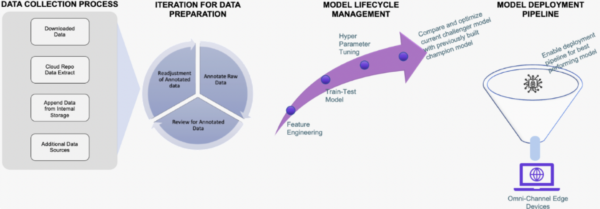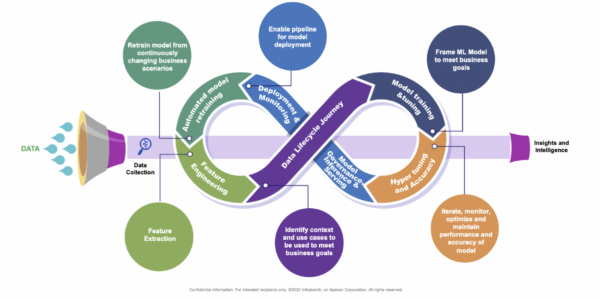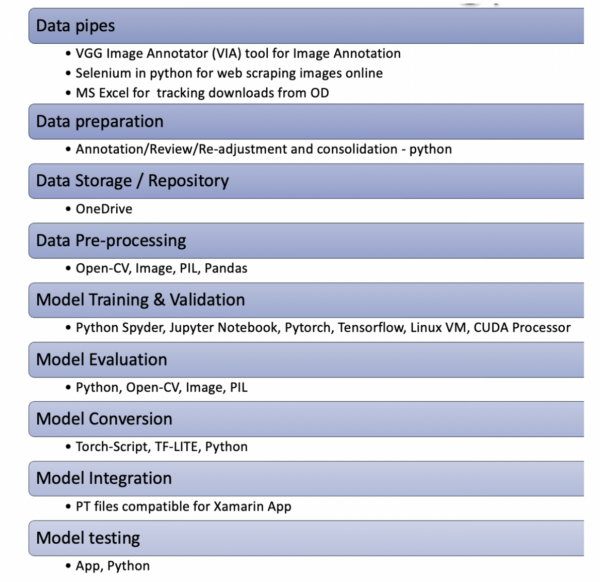
MLOps: Boost Operational Efficiency of ML Engineering Processes

From novelty to necessity, machine learning (ML) has become the most desired technology in every digital transformation initiative across various industries. Learning from data over time, it is an increasingly powerful technology to drive insights from the most complex use cases and scenarios, leading to greater perspicuity. However, most organizations are struggling to address and operationalize some of the complex and discrete use cases using ML partly due to the unstable manual process of deploying the models.
Shortening the analytics development lifecycle is a need for businesses today. To accomplish this, automating some of the repeatable steps in the model deployment is important. Establishing tight collaboration between data scientists (those who own and build the model) and engineers (those one who take this model, package it, and deploy it to the production environment) is necessary.
Let’s quickly explore some of the latest stats relating to ML:
- IDC predicts that “By 2024, 60% of enterprises will have operationalized their ML workflows through MLOps/ModelOps capabilities and AI-infused their IT infrastructure operations through AIOps capabilities”
- According to Algorithmia, close to 22% of companies have had machine learning models in production for 1-2 years
- At 31% of companies, data scientists spend more than half of their time on model deployment
- 97% of those who have implemented data/MLOps say they have made significant improvements as a result
Questions moving forward: What is the best way to enable collaboration between the ML-expert and operation-expert? What are the driving factors for MLOps?
Some thoughts:
- TCO shoots up due to an unoptimized process: TCO can be significantly high if teams start to operate in silos, resulting in costly process-related roadblocks and toil that waste valuable time and resources for ML-related initiatives
- Compatibility challenges (infrastructure, stack, and workload): System compatibility, version mismatches, or lack of standardization create challenges in supporting some of the complex use cases for AI/ML models execution and deployment. It requires MLOps to provide a unified platform to deploy, monitor, and manage the ML initiatives
- Context-driven businesses: High-penetration and reliance on the data and underlying context for new-age fast-evolving business models, products, and services to leverage the insights from context. Insight is the new secret key to unlocking the myth behind customer retention and lifetime value
Building an MLOps Pipeline
Now that we understand why MLOps is important, let’s look at how we can build one that is efficient and optimal.
At a very high level, MLOps process may consist of the following 4 stages:

When we scale such a process at the enterprise level with several hundred complex use cases consisting of several conditions and scenarios, it is not advisable to enable and apply ML to individual steps in a process. It is important to automate the end-to-end process to bring synergies among elements that are consistent across multiple steps, such as global variable usage, communication protocols, controls, common test cases, and documentation etc.
MLOps practices are primarily designed to focus on building models, tuning, monitoring, validation, and overall governance in productionizing aspects. Therefore, we design each of these steps from build to operationalization of model similar to DevSecOps practices, security, and testing of the overall pipeline. This ensures models are continuously getting updated and hyper-tuned with important business parameters. This MLOps pipeline should be integrated with code repo, webhooks, job schedule portal, runtime logic blocs, data sources, and logging mechanism to produce results like DevSecOps practices; the difference being its model that drives the change as opposed to the application or service.
As shown in the diagram below, MLOps encompasses the continuous learning of the scenarios, experimentation, and iteration to bring maturity in the machine learning lifecycle.

Operationalizing flawless MLOps practices is not as simple as it may sound. As enterprises are struggling to even migrate to the cloud, some are facing challenges while kick-starting their journey towards multi-cloud or even venturing into AI-ML world. MLOps for these organizations may look like an overwhelmingly complex and tedious process.
The following represents some of the shared challenges that organizations face as they go through their digital transformation journeys:
- Identification of a “real” and “relevant” pool of large data; acquiring and cleaning to maintain data integrity and trust is a mammoth task
- Enabling versioning for experiments, use case results and model training runs, and respective accuracy logs need technology and strategy
- Building pipelines for the models to test into upstream environments, security checks, and operationalizing requires coding knowledge and expertise
- Enabling the pipeline to continuously scale-out ML operations to meet fast-changing business processes and scenarios requires flawless design patterns and procedures
Apexon recommends its time-tested MLOps factory model along with MLOps readiness assessment, approach, and right methodology to address the challenges mentioned above. With all this in place, one can enable MLOps in a matter of weeks, helping to shorten their development cycles, boost deployment velocity, and enable system releases to become auditable and dependable.
Here are some of the best practices for MLOps to help accomplish business goals and objectives:
- Apexon MLOps Factory Model – Enable end-to-end visibility matrix on demand, supply, and outcome by analyzing inhouse resources and assets covering stack, tools, libraries, and features.
- Here are some of the tools and technologies that are beneficial while building a factory model:

- Here are some of the tools and technologies that are beneficial while building a factory model:
- Readiness Assessment Model – It is important to analyze the business use case and then choose the right algorithm that yields accurate results, tunes model parameters until the desired accuracy is obtained, and improves the data quality and integrity. There are plenty of open-source libraries available to improve model performance, as well as to perform trial runs and create reviewable and deployable code.
- Approach and Methodology– Continuously monitor, log and track model lineage, model versions, and manage model lifecycle. Enabling mechanism to discover, share, and collaborate new data patterns and their impact on ML models using MLOps platforms is key.
- Enable automated model deployment pipeline with end-to-end monitoring - Automate model lifecycle steps, permissions, and necessary infrastructure creation steps using IaC to build production-ready performant models.
Value Proposition of MLOPS
- Customer Lifetime Value and Retention – Having a robust industry-centric MLOps strategy to train-validate-maintain-governance-and-deploy error free models can yield great results, significantly improving speed-to-value. At Apexon, we have witnessed a greater than 20% improvement in customer lifetime value, which can be directly attributed to the use of MLOps.
- TCO Reduction - Having a continuous MLOps mechanism helps to eliminate silos between technical and business teams. Using MLOps to enable timely collaboration between stakeholders, at Apexon, we have seen a greater than 10% reduction in TCO, eliminating a day’s worth of silos.
Demand for digital engineering services continues to grow according to Zinnov. Being a pure-play digital engineering services firm, Apexon can assist with ML and boost your operational efficiency.
This blog was cowritten by Allan Gonsalves (Solutioning), Dr. Ramyaa (Process and Toolset) and Dipal Patel (Market Research)




